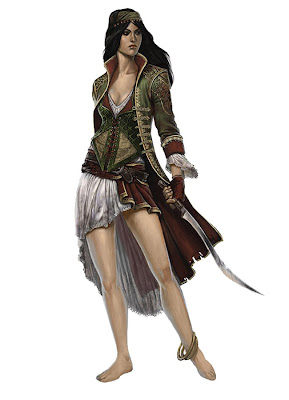Corsair
Image borrowed from: CreativeUncut.com
Corsair
Source for updates in Wikipedia: http://en.wikipedia.org/wiki/Corsair
Corsairs (French: corsaire) were privateers, authorized to conduct raids on shipping of a nation at war with France, on behalf of the French Crown. Seized vessels and cargo were sold at auction, with the corsair captain entitled to a portion of the proceeds. Although not French Navy personnel, corsairs were considered legitimate combatants in France (and allied nations), provided the commanding officer of the vessel was in possession of a valid Letter of Marque (fr. Lettre de Marque or Lettre de Course), and the officers and crew conducted themselves according to contemporary admiralty law. By acting on behalf of the French Crown, if captured by the enemy, they could claim treatment as prisoners of war, instead of being considered pirates. Because corsairs gained a swashbuckling reputation, the word "corsair" is also used generically as a more romantic or flamboyant way of referring to privateers, or even to pirates. The barbary pirates of North Africa as well as Ottomans were sometimes called "Turkish corsairs".
Contents[hide] |
[edit] Etymology
The word "corsair" comes directly from the French word corsaire, itself borrowed from the Italian corsaro. This derives from the Latin cursus, meaning "course" (as in journey or expedition).[1][2] The French word corsaire may also come as a mispronunciation of the Arabic word "corsan", yet the term pirate had been in use in French since the Middle Ages.[3]
[edit] History
The corsairs were privateers working for the King of France attacking the ships of France’s enemies. In France they did not need to fear punishment for piracy—being hanged—as they were granted a licence as combatants, the Lettre de Marque or Lettre de Course, a document which legitimised their actions to the French justice system and which they hoped gave them the status of a war prisoner in case they were ever captured.
The corsair was ordered to attack only the ships of enemy countries, theoretically respecting "neutrals" and his own nation's ships. If he did not respect this rule, he was then treated as a pirate and hanged. The corsairs' activities also provided the King with revenue as the licence required them to hand over a part of their booty to the King.
In common with privateers of other nationalities, however, they were often considered pirates by their foreign opponents, and could be hanged as pirates if captured by the foreigners they preyed on.
The "corsair" activities started in the Middle Ages the main goals really being to compensate for the economic problems in war periods; and the ship owners did not accept that the war was an obstacle to their trade. Jean de Châtillon, who was a bishop, in 1144 gave the town of Saint-Malo the status of rights of asylum which encouraged all manner of thieves and rogues to move there. Their motto was "Neither Breton, nor French, but from Saint-Malo am I!". Saint-Malo however, progressed and in 1308 the town was made into a free commune to encourage the commercial activities of craftsmen as well as merchants and ship owners. This did not really work out and later in 1395 the town became a free port. This situation continued until 1688.
Between the early 1500s and 1713 when the signing of the treaty of Utrecht effectively put an end to the French corsair raids in the Caribbean, the Guerre de Course, as the French called it, took a huge toll on the Spanish Treasure Fleet's efforts to ship the gold and silver from Peru to Santo Domingo and La Havana and then on to Spain. During this period, there was a very intense drive to improve, not only the speed of the ships involved in this contest, but also their maneuverability and ability to sail into the wind (the close haul). It was a matter of life or death, and immense wealth was at stake. Jean d'Ango, father and son, came to be among the wealthiest and most influential men in France. Giovanni da Verrazano (of Verrazano-Narrows fame) and Jean Fleury are among the unsung heroes of this epic saga about which so little has been written.
It is not a coincidence that during this brief span of 200 years, almost all the modern sail configurations were developed; more than in the 2000 years before and 300 years since. We see the spritsail (maneuvre) come and go, the topsails appear (speed), and the gaff rig (both) evolves from the voile au tiers dear to the corsairs. Flying jibs (very close reach) start to fill in the spaces between the masts and will eventually consolidate into the great Genovese sail. The Bermuda sail makes its appearance and with it the fore and aft rig is poised to definitively take over from the traditional square rigs. Greater speed and nimble handling are the key to surviving the bitter combats that occurred between Cartagena on the Spanish Main and the great Caribbean islands of Hispaniola in the beginning and later Cuba.
The activities of the corsairs were so profitable that the Minister of the Navy used this in his strategy to make money. Moreover, the King used to take one quarter and even one third of the booty. The corsairs' activities weakened France's enemies; indeed, the English trade losses were very important from 1688 until 1717.
The relationship between the corsairs and the State changed depending on who was leader. The rules became stricter and State control more and more present. At the end of the 18th century, the "course" started to decline until its legal death in 1856. The "course" disappeared in France with the Empire in 1815, but was officially ended only in 1856 during a meeting in Paris, where every major nation except Spain, Mexico and United States was present during the Congress of Vienna.
[edit] Famous corsairs
| This section requires expansion. |
[edit] Female corsairs
In the 14th century Jeanne de Montfort, nicknamed "The Flame", sailed in the English Channel plundering French ships, fighting with the English for Brittany's independence. She played an important role in the Battle of Morlaix. Another woman, Jeanne de Clisson, was known as "The Lioness of Brittany".
[edit] Male corsairs
[edit] Jean-François Roberval
Jean-François de La Roque de Roberval (c. 1500–1560) was a French nobleman and adventurer who, through his friendship with King Francis, became the first Lieutenant General of New France. As a corsair, he attacked towns and shipping throughout the Spanish Main, from Cuba to Colombia. He died a Huguenot martyr.
Jean-François Roberval (c. 1500- 1560) was a lifelong friend of King Francis. When his appointment as the first Lieutenant General of New France did not work out, he attempted to pay off his debts through privateering. The Spanish Caribbean was his main target, since at that time France and Spain were at war. Known to the Spanish as Roberto Baal,[4] in 1543 he sacked Rancherias and Santa Marta, followed by an attack in 1544 on Cartagena de Indias.[5] In 1546, ships under his command attacked Baracoa and Havana. The next year, he retired from pirating.
[edit] René Duguay-Trouin
René Duguay-Trouin was born in Saint-Malo in 1673, and the son of a rich ship owner took a fleet of 64 ships and was honoured in 1709 for capturing more than 300 merchant ships and 20 warships. He had a brilliant privateering and naval career and eventually became "Lieutenant-General of the Naval Armies of the King", i.e., admiral, (French:Lieutenant-Général des armées navales du roi), and a Commander in the Order of Saint-Louis. He died peacefully in 1736.
[edit] Robert Surcouf
Robert Surcouf was the last and best known corsair of Saint-Malo. Born there in 1773, his father was a ship owner and his mother the daughter of a captain. Ship's boy at 13 and corsair captain at 22 years old, and then — very much against his licence — for several years attacked ships including those of the French East India Company, or Compagnie Française des Indes. During the French Revolution, the convention government disapproved of lettres de course, so Surcouf operated at great personal risk as a pirate against British shipping to India. Surcouf was so successful that he became a popular celebrity in France. After a brief early retirement Surcouf again operated against shipping to the Indies. Surcouf became a ship owner himself and died in Saint-Malo in 1827. There is a statue of him on public display.
[edit] References
- ^ Dictionnaire de L'Académie Française, 9e edition en ligne
- ^ http://www.etymonline.com/index.php?term=corsair
- ^ Template:Ouvrage
- ^ Gerassi-Navarro, Nina (1999) Pirate Novels: Fictions of Nation Building in Spanish America Duke University Press, Durham, p. 22, discussing real pirates;
- ^ Lane, Kris E. (1998). Pillaging the Empire: Piracy in the Americas, 1500-1750. Armonk: M.E. Sharpe. ISBN 0765602571.
[edit] See also
| Look up corsair in Wiktionary, the free dictionary. |
[edit] Weblinks
- a Swiss/German page showing financial documents related to corsairs: "Die sehr geehrten Freibeuter" (the honorable bucaneers)



Comments
Post a Comment